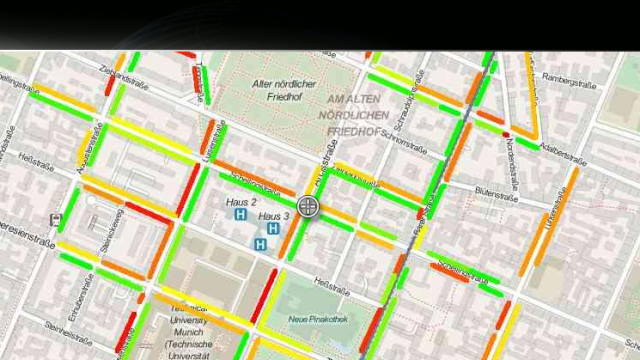A full third of all vehicular congestion in cities is estimated to be caused by people circling — and circling… and circling… and circling — as they look for parking. A new tool that will be onboard all new BMWs will aggregate real-time data to point drivers towards potential parking spaces and away from inevitable parking headaches.
On-Street Parking, a new tool developed by nav data powerhouse Inrix, will be displayed on BMW’s dashboard screens just like the navigation system drivers are already familiar with. Similarly to the way travel times are denoted by green, yellow, and red lines on roads, On-Street Parking colour-codes each side of the streets in the immediate vicinity based on available spots. Green means chances are very good for parking; red means avoid this block at all costs.
How could such magic be possible? I’d written previously about an app called PocketParker which works by collecting local smartphone data — it can estimate where parking is available by looking for certain behavioural cues which mean people are about to abandon a spot.
Inrix uses smartphone data, too, but supplements with additional information like transactions from parking meters (which are surprisingly helpful) and public data from cities. Plus Inrix also has the data it’s collecting in real time from all the other Inrix devices already onboard cars out there — about 250 million units. By crunching all this data, the software can estimate fairly accurately and in real time where an empty spot is most likely to be.
As the Inrix engineers freely admit, it’s not completely accurate — although in tests they managed to get it right about 80 per cent of the time. But it is more accurate than the alternative. By using so many different, overlapping data sources, this software can actually be more accurate than the physical road sensors that some cities have installed in their parking spots for the same use, which have proved to be expensive and unreliable.
Where this kind of technology will really shine is in a few years when all cars are connected — which will be coming even sooner thanks to the Department of Transportation ramping up the timeline for required v2v tech on all vehicles. Cars will be able to share information with each other about when they’re looking for or vacating a spot. And when you plan a trip with your navigation system, instead of taking you to the actual address, the car will route you to the best available parking spot. That’s almost as good as a self-driving car.
[Inrix]
